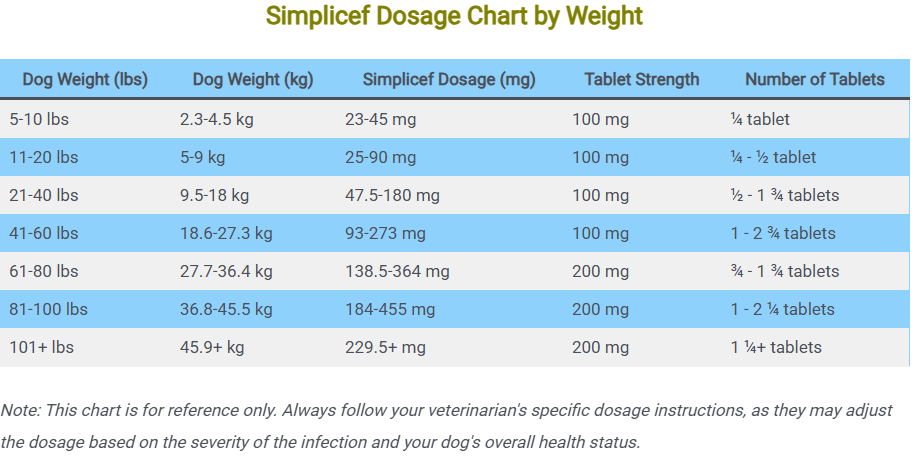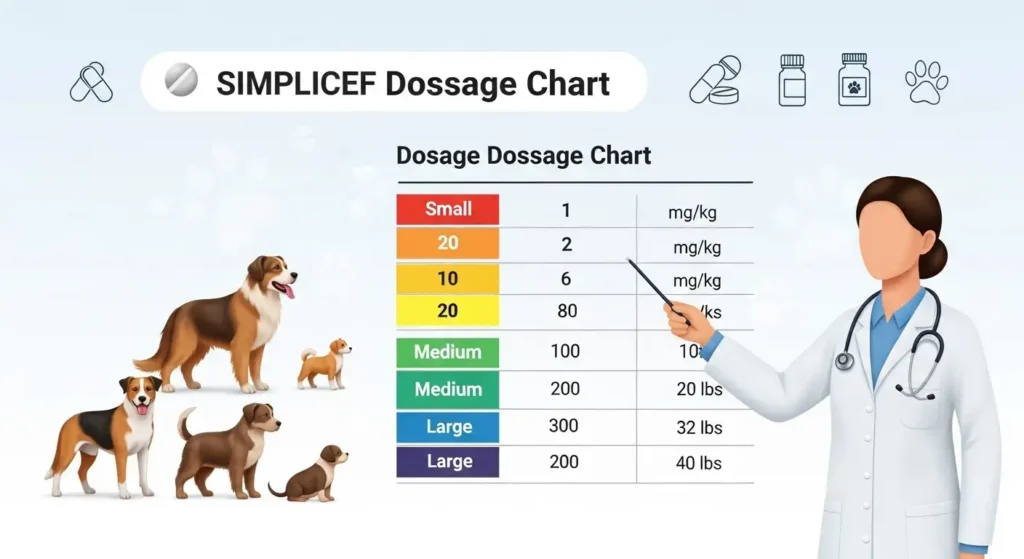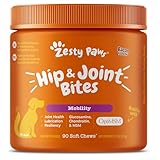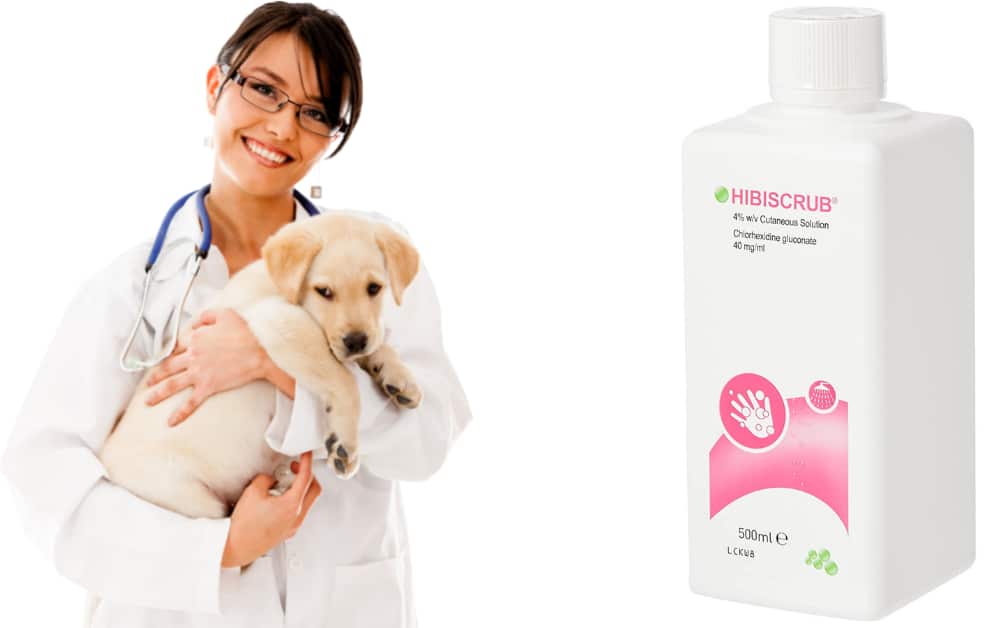Simplicef for dogs is a veterinarian-prescribed antibiotic medication containing cefpodoxime proxetil that effectively treats a wide range of bacterial infections in canines. This third-generation cephalosporin antibiotic works by inhibiting bacterial cell wall synthesis, ultimately eliminating harmful bacteria from your dog’s system.
The proper dosage of Simplicef varies based on your dog’s weight and the type of infection being treated, making it essential to follow your veterinarian’s specific instructions.
When administered correctly, Simplicef can help treat skin infections, urinary tract infections, respiratory infections, and other bacterial conditions, helping your furry friend recover quickly and safely.
Key Takeaways
- Simplicef (cefpodoxime proxetil) is a prescription antibiotic used to treat various bacterial infections in dogs
- The standard dosage is typically 5-10 mg per kg of body weight, administered once daily
- Dosage may vary depending on the type and severity of the infection
- Always complete the full course of antibiotics even if your dog appears to have recovered
- Common side effects include gastrointestinal upset, though serious reactions are rare
- Never administer Simplicef without veterinary supervision or use leftover medication
- Store at room temperature away from moisture and heat
What is Simplicef for Dogs?
Simplicef for dogs is the brand name for cefpodoxime proxetil, an antibiotic medication specifically formulated for canine use. This broad-spectrum antibiotic belongs to the cephalosporin class and is commonly prescribed by veterinarians to treat various bacterial infections.
As a third-generation cephalosporin, Simplicef is effective against both gram-positive and gram-negative bacteria, making it a versatile treatment option for many common canine infections.
The medication comes in tablet form in various strengths (100 mg and 200 mg), allowing for precise dosing based on your dog’s weight and condition. Simplicef is only available with a prescription from a licensed veterinarian, as proper diagnosis and dosage determination are critical for safe and effective treatment.
Simplicef® Dosage For Dogs
The appropriate dosage of Simplicef depends primarily on your dog’s body weight. The standard recommended dosage is 5-10 mg per kilogram (kg) of body weight, administered once every 24 hours. Below is a comprehensive dosage chart to help you understand the typical dosage based on weight ranges:
Simplicef Dosage For Dogs Chart by Weight
| Dog Weight (lbs) | Dog Weight (kg) | Simplicef Dosage (mg) | Tablet Strength | Number of Tablets |
|---|---|---|---|---|
| 5-10 lbs | 2.3-4.5 kg | 23-45 mg | 100 mg | ¼ tablet |
| 11-20 lbs | 5-9 kg | 25-90 mg | 100 mg | ¼ – ½ tablet |
| 21-40 lbs | 9.5-18 kg | 47.5-180 mg | 100 mg | ½ – 1 ¾ tablets |
| 41-60 lbs | 18.6-27.3 kg | 93-273 mg | 100 mg | 1 – 2 ¾ tablets |
| 61-80 lbs | 27.7-36.4 kg | 138.5-364 mg | 200 mg | ¾ – 1 ¾ tablets |
| 81-100 lbs | 36.8-45.5 kg | 184-455 mg | 200 mg | 1 – 2 ¼ tablets |
| 101+ lbs | 45.9+ kg | 229.5+ mg | 200 mg | 1 ¼+ tablets |
Note: This chart is for reference only. Always follow your veterinarian’s specific dosage instructions, as they may adjust the dosage based on the severity of the infection and your dog’s overall health status.
How Does Simplicef Work?
Simplicef works by interfering with the bacterial cell wall synthesis, ultimately causing the bacteria to die off. The active ingredient, cefpodoxime proxetil, is a prodrug that is absorbed in the gastrointestinal tract and then converted to its active form, cefpodoxime.
This active form binds to specific proteins in the bacterial cell wall, preventing the bacteria from forming proper cell walls. Without intact cell walls, the bacteria cannot survive or reproduce, allowing your dog’s immune system to eliminate the infection.
What makes Simplicef particularly effective is its ability to resist degradation by beta-lactamases, enzymes produced by some bacteria to inactivate antibiotics. This resistance allows Simplicef to remain effective against bacteria that might be resistant to other antibiotics.
Common Infections Treated with Simplicef®
Veterinarians commonly prescribe Simplicef for dogs to treat a variety of bacterial infections, including:
Skin Infections (Pyoderma)
- Superficial pyoderma (bacterial infections of the skin surface)
- Deep pyoderma (bacterial infections involving deeper skin layers)
- Wound infections
- Hot spots (acute moist dermatitis with secondary bacterial infection)
Urinary Tract Infections (UTIs)
- Bladder infections (cystitis)
- Kidney infections (pyelonephritis)
- Prostate infections (prostatitis)
Respiratory Infections
- Bacterial pneumonia
- Tracheobronchitis
- Rhinitis and sinusitis
Other Infections
- Otitis externa and media (ear infections)
- Periodontal infections
- Soft tissue infections
- Certain bone infections
The effectiveness of Simplicef against these infections has been well-documented in clinical studies, making it a trusted choice among veterinarians for treating bacterial infections in dogs.
Simplicef Dosage by Infection Type
While weight is the primary factor in determining Simplicef dosage, the type and severity of the infection can also influence the exact dosage prescribed by your veterinarian. Here’s a breakdown of typical dosage recommendations based on infection type:
Skin Infections
For mild to moderate skin infections, veterinarians typically prescribe the standard dosage of 5-10 mg/kg once daily. For more severe or deep skin infections, your veterinarian might prescribe the higher end of the dosage range (8-10 mg/kg) or extend the treatment duration.
Urinary Tract Infections
Uncomplicated UTIs usually respond well to the standard dosage of 5-10 mg/kg once daily for 7-14 days. For complicated or recurrent UTIs, your veterinarian might prescribe a longer course of treatment (up to 28 days) at the higher end of the dosage range.
Respiratory Infections
For bacterial respiratory infections, the standard dosage of 5-10 mg/kg once daily is typically prescribed. The duration of treatment usually ranges from 7-14 days, depending on the severity of the infection and your dog’s response to the medication.
Ear Infections
For otitis externa or media, the standard dosage of 5-10 mg/kg once daily is commonly prescribed. Treatment duration typically ranges from 7-14 days, though your veterinarian might recommend a longer course for chronic or severe infections.
| Infection Type | Typical Dosage Range | Standard Treatment Duration | Special Considerations |
|---|---|---|---|
| Skin Infections | 5-10 mg/kg once daily | 7-21 days | Higher dosage may be needed for deep pyoderma |
| Urinary Tract Infections | 5-10 mg/kg once daily | 7-28 days | Longer duration for recurrent infections |
| Respiratory Infections | 5-10 mg/kg once daily | 7-14 days | May need additional supportive care |
| Ear Infections | 5-10 mg/kg once daily | 7-14 days | Often combined with topical treatments |
| Wound Infections | 5-10 mg/kg once daily | 7-14 days | May require wound cleaning and debridement |
Note: These are general guidelines. Your veterinarian will determine the exact dosage and duration based on your dog’s specific condition.
How to Administer Simplicef to Your Dog
Proper administration of Simplicef for dogs is crucial for ensuring its effectiveness and minimizing potential side effects. Here’s a step-by-step guide to help you administer this medication correctly:
Preparation
- Wash your hands thoroughly before handling the medication.
- Confirm the correct dosage with your veterinarian’s prescription.
- If needed, use a pill cutter to split tablets accurately for precise dosing.
Administration Methods
- Direct Oral Administration:
- Hold the tablet between your thumb and index finger.
- Gently grasp your dog’s muzzle from above with your other hand.
- Tilt your dog’s head back slightly, which will cause their jaw to drop naturally.
- Place the tablet as far back on the tongue as possible.
- Close your dog’s mouth and hold it shut while gently stroking their throat to encourage swallowing.
- Watch for swallowing motions, and offer a treat or praise afterward.
- With Food:
- Simplicef can be given with or without food, but if your dog experiences gastrointestinal upset, administering it with a meal may help.
- Hide the tablet in a small amount of your dog’s favorite food, such as peanut butter, cheese, or a soft treat.
- Ensure your dog consumes the entire portion to receive the full dose.
- Compounded Liquid Form:
- For dogs that refuse tablets, your veterinarian may be able to compound Simplicef into a liquid form.
- Use the provided syringe or dropper to measure the exact dose.
- Gently insert the syringe into the side of your dog’s mouth, between the cheek and gums.
- Slowly dispense the medication, allowing your dog to swallow naturally.
Tips for Success
- Administer the medication at the same time each day to maintain consistent antibiotic levels in your dog’s system.
- If you forget a dose, give it as soon as you remember, unless it’s almost time for the next dose. In that case, skip the missed dose and resume the regular schedule. Do not double up on doses.
- Always complete the full course of antibiotics, even if your dog appears to have recovered. Stopping early can lead to antibiotic resistance and recurrence of the infection.
- Monitor your dog for any side effects or adverse reactions, and report them to your veterinarian promptly.
Potential Side Effects of Simplicef
While Simplicef for dogs is generally well-tolerated, like any medication, it can cause side effects in some dogs. Most side effects are mild and temporary, but it’s important to be aware of them and contact your veterinarian if they persist or worsen.
Common Side Effects
- Gastrointestinal upset (vomiting, diarrhea, decreased appetite)
- Nausea
- Lethargy or drowsiness
- Hyperactivity or restlessness (less common)
Less Common Side Effects
- Allergic reactions (hives, facial swelling, difficulty breathing)
- Yeast or fungal infections (due to disruption of normal flora)
- Changes in liver enzyme values (detected through blood tests)
- Neurological symptoms (seizures, incoordination) – rare
When to Contact Your Veterinarian
Contact your veterinarian immediately if you notice any of the following:
- Severe or persistent vomiting or diarrhea
- Signs of an allergic reaction (hives, swelling, difficulty breathing)
- Seizures or other neurological symptoms
- Extreme lethargy or weakness
- Any other unusual or concerning symptoms
It’s worth noting that the risk of side effects can be minimized by following your veterinarian’s dosage instructions carefully and administering the medication as directed.
Precautions and Contraindications
Before administering Simplicef for dogs, it’s important to be aware of certain precautions and contraindications to ensure the safety of your pet.
Dogs Who Should Not Take Simplicef
- Dogs with a known hypersensitivity or allergy to cefpodoxime or other cephalosporin antibiotics
- Dogs with a history of severe allergic reactions to penicillin or other beta-lactam antibiotics (cross-reactivity may occur)
- Dogs with severe kidney dysfunction (dosage adjustment may be necessary)
Special Precautions
- Pregnant or Nursing Dogs: The safety of Simplicef in pregnant or nursing dogs has not been fully established. Use only if the potential benefits outweigh the risks.
- Puppies: Simplicef is generally safe for puppies, but dosage adjustments may be necessary for very young or small puppies.
- Dogs with Kidney Disease: Since Simplicef is primarily eliminated through the kidneys, dogs with impaired kidney function may require dosage adjustments or alternative treatments.
- Dogs with Liver Disease: While less common, dogs with severe liver disease may also require special considerations when taking Simplicef.
- Dogs with a History of GI Issues: Dogs with a history of gastrointestinal disease may be more prone to developing diarrhea or other GI side effects.
Monitoring Requirements
Your veterinarian may recommend certain monitoring while your dog is taking Simplicef, especially for long-term treatment or if your dog has pre-existing health conditions:
- Regular check-ups to assess treatment progress
- Blood tests to monitor liver and kidney function (especially for prolonged treatment)
- Monitoring for signs of secondary infections (e.g., yeast infections)
Always provide your veterinarian with a complete medical history for your dog, including any known allergies, current medications, and pre-existing health conditions, before starting Simplicef treatment.
Drug Interactions to Be Aware Of
Simplicef for dogs may interact with other medications, potentially affecting its efficacy or increasing the risk of side effects. It’s crucial to inform your veterinarian about all medications, supplements, and herbal products your dog is currently taking or has recently taken.
Significant Drug Interactions
- Antacids and H2 Blockers: Medications like famotidine (Pepcid), cimetidine (Tagamet), or antacids containing aluminum, magnesium, or calcium can reduce the absorption of Simplicef. If your dog needs these medications, administer them at least 2 hours before or after giving Simplicef.
- Probenecid: This medication, sometimes used to treat gout, can increase the concentration of Simplicef in the blood by reducing its elimination, potentially increasing the risk of side effects.
- Other Antibiotics: Combining Simplicef with certain other antibiotics may either enhance or reduce its effectiveness. Your veterinarian will carefully consider any antibiotic combinations.
- Aminoglycosides: Concurrent use of Simplicef with aminoglycoside antibiotics (such as gentamicin) may increase the risk of kidney damage.
- Loop Diuretics: Medications like furosemide (Lasix) may increase the risk of kidney damage when used with Simplicef.
- Warfarin: Simplicef may potentially enhance the anticoagulant effects of warfarin, increasing the risk of bleeding.
Food and Supplement Interactions
- Dairy Products: While not a significant interaction, high-calcium foods or supplements may slightly reduce the absorption of Simplicef. It’s generally best to administer the medication separately from large amounts of dairy products.
- Iron Supplements: Iron supplements can bind with Simplicef and reduce its absorption. If your dog requires iron supplements, administer them at least 2 hours apart from Simplicef.
Always consult with your veterinarian before starting, stopping, or changing any medications while your dog is taking Simplicef. Your veterinarian can provide guidance on managing potential interactions and adjusting dosages if necessary.
What to Do If You Miss a Dose
- Administer the missed dose as soon as you remember.
- Continue with the regular dosing schedule for subsequent doses.
- Try to maintain at least some interval between doses (e.g., if you normally give the medication at 8 AM and missed the morning dose but remember at noon, give the dose then and continue with the next dose at 8 AM the following day).
If It’s Almost Time for the Next Dose
- Skip the missed dose entirely.
- Resume the regular dosing schedule with the next dose.
- Do not double up on doses to make up for the missed one, as this can increase the risk of side effects.
If You Miss Multiple Doses
- Contact your veterinarian for guidance.
- Depending on how many doses were missed and the nature of the infection being treated, your veterinarian may recommend:
- Resuming the regular schedule
- Adjusting the remaining treatment duration
- In some cases, restarting the treatment course
Tips for Remembering Doses
To help avoid missing doses in the future:
- Set reminders on your phone or calendar
- Use a pill organizer designed for pet medications
- Keep the medication in a visible location (away from pets and children)
- Incorporate medication time into a daily routine (e.g., after breakfast or before bedtime)
- Ask a family member to help remind you
Remember that consistency is key when administering antibiotics. Missing doses can reduce the effectiveness of the treatment and potentially contribute to antibiotic resistance.
Storage Instructions for Simplicef
Proper storage of Simplicef is essential to maintain its effectiveness and ensure the safety of your pet. Follow these storage guidelines:
Temperature and Environment
- Store Simplicef tablets at room temperature, between 68°F and 77°F (20°C and 25°C).
- Avoid exposing the medication to extreme temperatures or direct sunlight.
- Do not store in the bathroom or near the kitchen sink, as moisture and heat can affect the medication’s stability.
- Keep the medication in its original container with the lid tightly closed to protect it from moisture.
Safety Considerations
- Store Simplicef in a secure location out of reach of children and pets.
- Do not use Simplicef after the expiration date printed on the packaging.
- Do not use any tablets that appear discolored, damaged, or show signs of deterioration.
- Keep track of the number of tablets remaining to ensure you complete the full course of treatment.
Disposal of Unused Medication
- If you have leftover Simplicef after completing the prescribed treatment, do not save it for future use.
- Do not flush unused medication down the toilet or pour it down the drain unless specifically instructed to do so.
- The preferred disposal method is through a community drug take-back program or pharmacy take-back program.
- If no take-back programs are available, mix the unused medication with an undesirable substance (like used coffee grounds or cat litter), place it in a sealed plastic bag, and dispose of it in the household trash.
- Remove all personal information from the medication container before disposing of it.
Travel Considerations
- If traveling with your dog and their medication, keep Simplicef in its original container with the prescription label intact.
- Use a small cooler with ice packs if traveling in hot weather, but ensure the medication doesn’t freeze or come into direct contact with the ice.
- Carry a copy of the prescription when traveling, especially if crossing state lines or international borders.
Proper storage not only ensures the medication’s effectiveness but also prevents accidental ingestion by children or other pets, which could be harmful.
FAQs
What is Simplicef used for in dogs?
Simplicef (cefpodoxime proxetil) is a broad-spectrum antibiotic used to treat various bacterial infections in dogs, including skin infections, urinary tract infections, respiratory infections, and ear infections. It works by inhibiting bacterial cell wall synthesis, ultimately eliminating the infection-causing bacteria.
How quickly does Simplicef work in dogs?
Many dogs show improvement within 2-3 days of starting Simplicef treatment. However, it’s essential to complete the full course of antibiotics as prescribed by your veterinarian, even if your dog appears to have recovered. Stopping treatment early can lead to antibiotic resistance and recurrence of the infection.
Can Simplicef be given with food?
Yes, Simplicef can be administered with or without food. If your dog experiences gastrointestinal upset when taking the medication on an empty stomach, giving it with a small meal or treat may help reduce these side effects.
Final Thoughts:
Simplicef for dogs is a valuable antibiotic medication that effectively treats a wide range of bacterial infections in canines. When used according to your veterinarian’s instructions, it can help your dog recover from infections while minimizing the risk of side effects and antibiotic resistance.
Remember that the appropriate dosage of Simplicef depends on your dog’s weight and the type of infection being treated. Always follow your veterinarian’s specific dosage instructions and complete the full course of treatment, even if your dog appears to have recovered.
By understanding how to properly administer Simplicef, recognize potential side effects, and store the medication correctly, you can help ensure the best possible outcome for your furry friend. If you have any concerns or questions about your dog’s treatment with Simplicef, don’t hesitate to consult your veterinarian for guidance.
With proper veterinary care and responsible medication administration, Simplicef can be an effective tool in maintaining your dog’s health and well-being when faced with bacterial infections.










